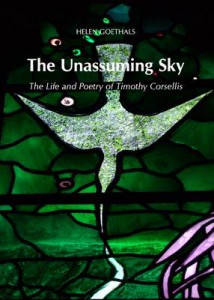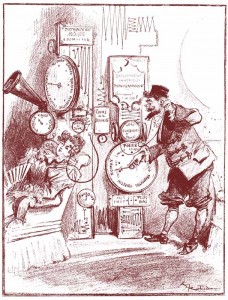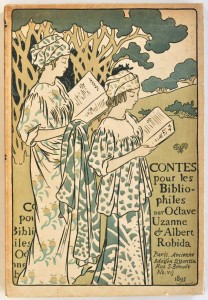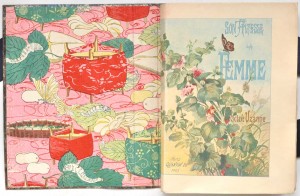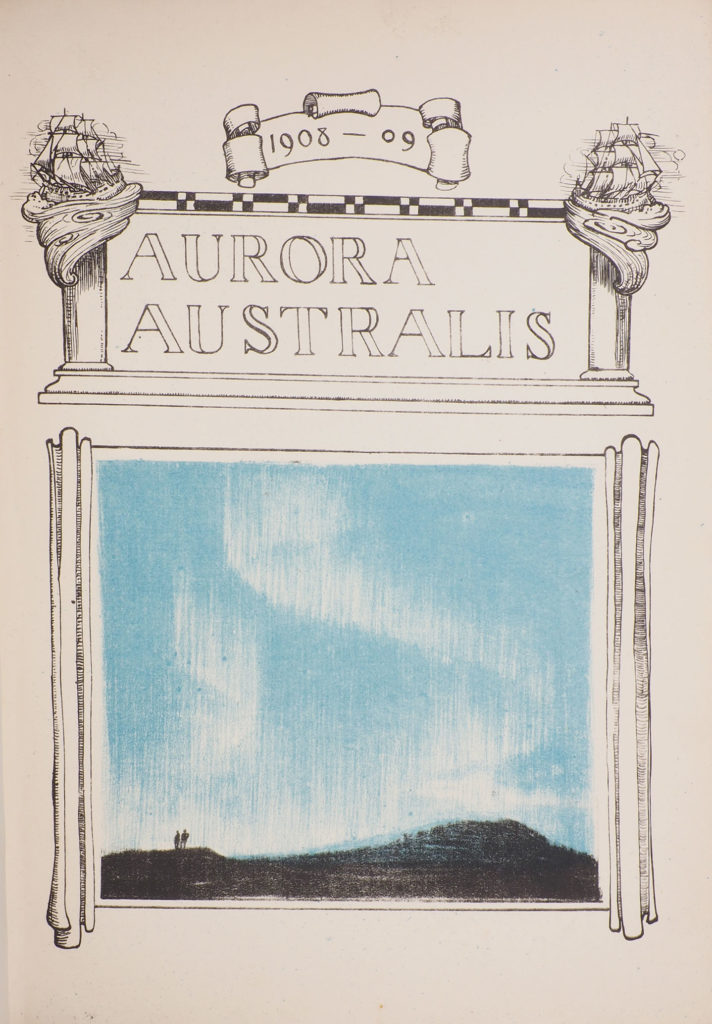
Written, printed and bound in the depths of an Antarctic winter, Aurora Australis is one of the most extraordinary of all twentieth-century books.
It was created during the fabled Nimrod expedition which took Shackleton to within 100 miles of the South Pole. As the first book printed in Antarctica it is the pinnacle of polar book collecting. The edition was printed in fewer than 100 copies, for private circulation only, of which less than 70 copies can now be accounted for. Copies were never offered for sale, but were given instead to sponsors and others who had made the expedition possible.
In the centenary year of Shackleton’s death, it is a privilege to be introducing a rediscovered copy of Aurora Australis, with its interesting and important provenance. It will be exhibited, for the first time, at the New York Antiquarian Book Fair, April 2022.
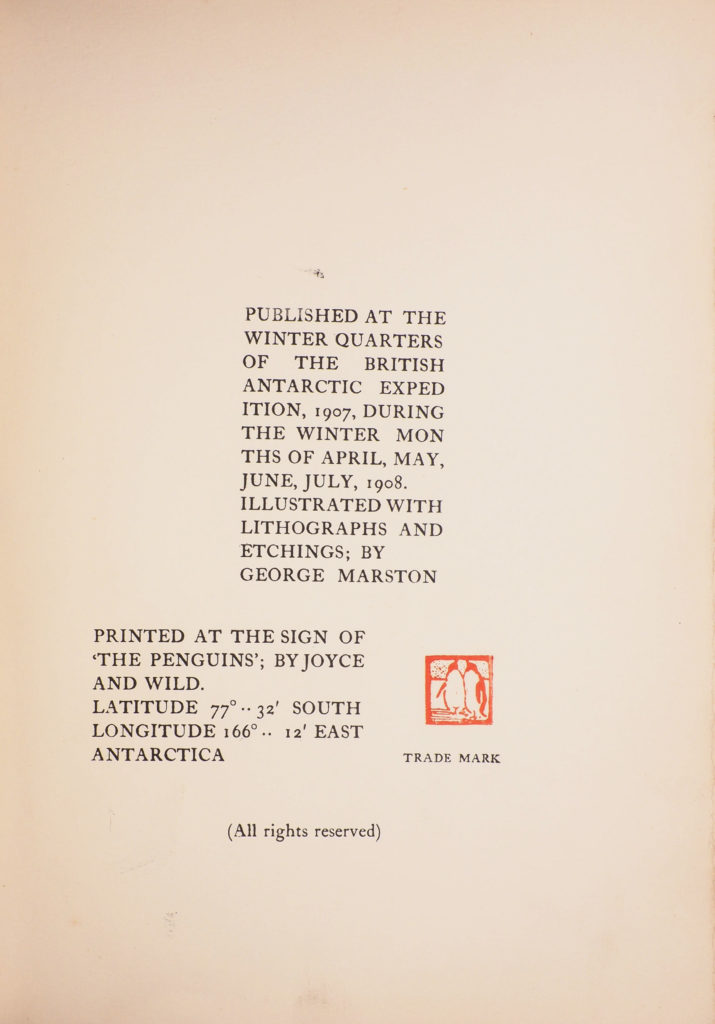
The book bears the imprint ‘Published at the Winter Quarters of the British Antarctic Expedition, 1907 During the Winter Months of April, May, June, July, 1908… Printed at the Sign of ‘The Penguins’; by Joyce and Wild. Latitude 77°.. 32′ South Longitude 166°.. 12′ East’, together with the little red printer’s mark of two penguins.
Contributions of text and images for Aurora Australis were made by all the expedition members and contemporary photographs show the two presses (one for the text, the other for plates) wedged into the cabins of Shackleton’s winter quarters at Cape Royds. Here the book’s printers, Ernest Joyce, James Murray and George Marston, pitted themselves against the elements to create a work of incredible accomplishment.
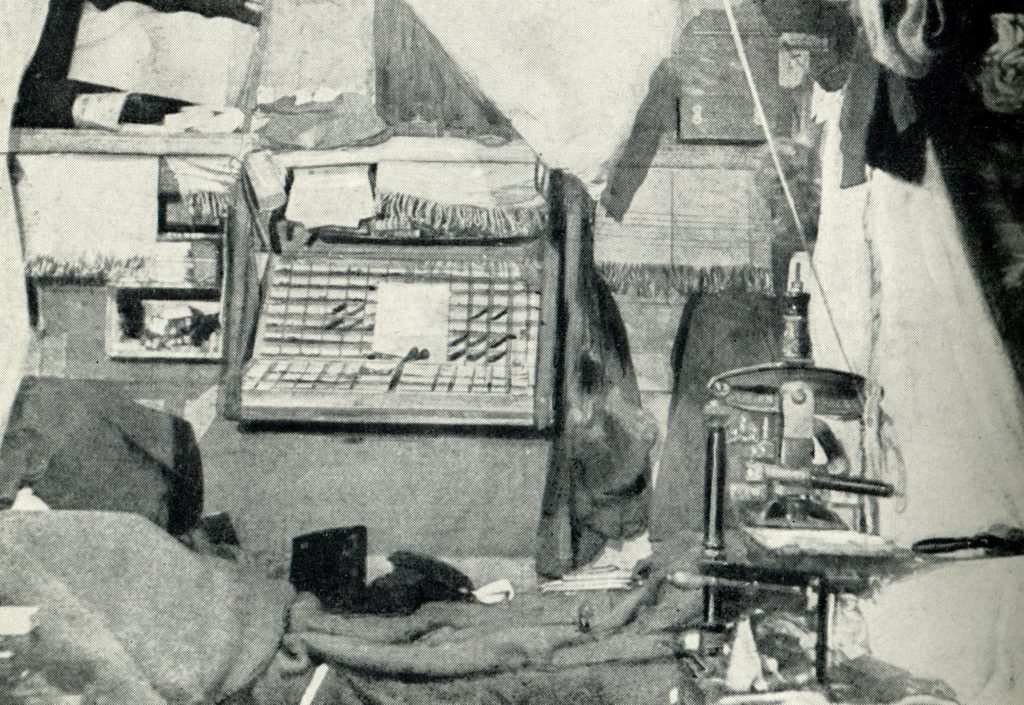
They recalled: ‘It is too cold to keep the printer’s ink fluid; it gets sticky and freezes. To cope with this a candle was set burning underneath the plate on which the ink was. This was all right, but it made the ink too fluid, and the temperature had to be regulated by moving the candle about.’ (Antarctic Days, 1913).
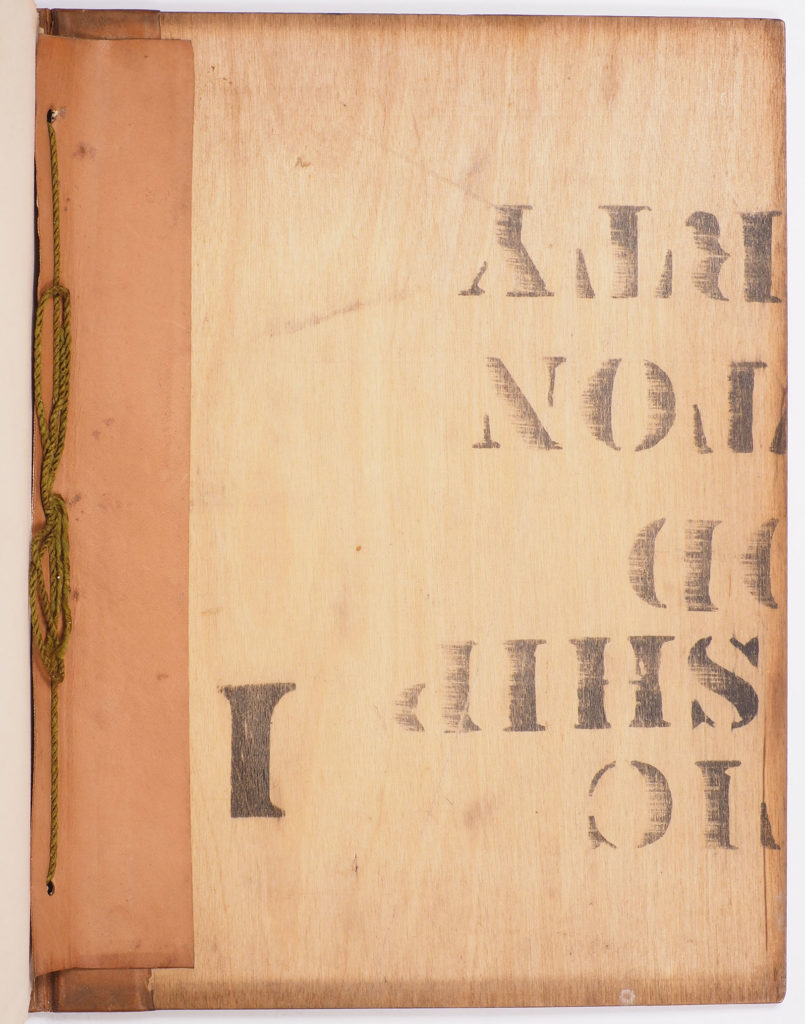
After this laborious printing process, the sheets were assembled and bound in boards of recycled plywood packing cases and backed with leather from the expedition’s pony harnesses. Each copy of Aurora Australis is slightly different, since their covers were purloined from a variety of different cases, with different stencilled labels. The lower board of this copy bears fragments of the stencilled words ‘Antarctic Ship Nimrod Lyttleton Party’.
The front endpaper of this copy also bears a pencil inscription in an unknown hand to ‘D. Kennedy Jones’, referring to Dorothy, daughter of the newspaperman William Kennedy Jones.
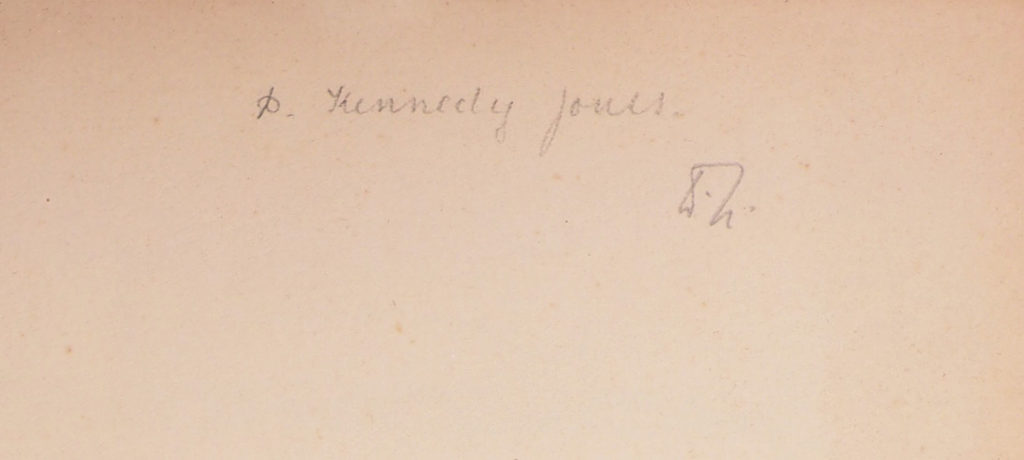
Kennedy Jones (known to most as ‘K.J.’) was Lord Northcliffe’s business manager at the Daily Mail, the newspaper which had obtained exclusive rights to Shackleton’s expedition to the South Pole, and which was the first to print news of its progress. Though the copy is not recognisably inscribed by any member of the expedition party, the proprietors of the Daily Mail would be obvious recipients of copies of Aurora Australis, though no such presentation (to either Northcliffe or Kennedy Jones) has previously been recorded. The inscription is apparently signed ‘W.H.’ and it has been suggested that this may be (or made on behalf of) William Heinemann, Shackleton’s publisher.
The Kennedy Jones copy has remained in the family, by descent, to the present day.
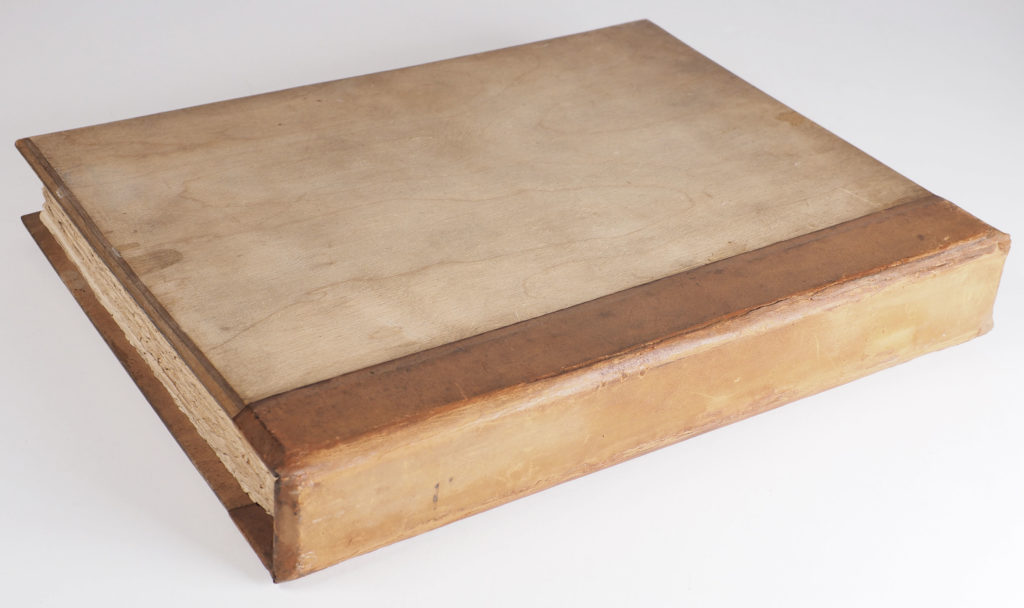
There is some variation between copies of Aurora Australis, given the mode of printing and binding, but this is a typical copy with eleven plates. A few copies have ten plates only (lacking the ‘Many shekels’ plate and having text in its place) which are argued to represent a first ‘state’ (‘Aurora Australis … A new Description of the first State’, Martin L. Greene in Book Talk, 2006). Copies can also vary in having a final caption leaf for a subsequently cancelled plate (‘A Giant Tick…’) or not. Ours is without. The most interesting variation is in the boards used for the binding, which used different sections of the many venesta plywood packing cases used for expedition supplies. Front and rear boards can bear stencilled lettering on their inside surfaces or be blank. The Kennedy Jones copy has the first board blank and the lower board with portions of the words and letters [Antarct]ic Ship [Nimro]d [Lyttle]ton Pa[rty]. The leather backing, recycled from the pony harnesses (all the expedition’s ponies perished) is fragile and prone to cracking and further degradation. Copies are often rebacked, preserving as much of the original spine as possible, but in the present copy the backing is present in its entirety, the joints carefully and unobtrusively repaired by James Brockman.
‘At most 100 copies were produced, but probably significantly fewer. Approximately 65 copies have been accounted for to date. At this time, about half are in museums or permanent institutional collections and half are in private hands’ (Rosove, 2001). The present copy was not known to Rosove and does not appear in Martin Greene’s Antarctic Circle census online. It is an important rediscovery. Please contact us for further details.
4to (260 ×165 mm), 93 leaves, including blanks, colour printed title and 11 plates. Bound by Bernard Day in original ‘venesta’ boards taken from expedition packing crates, backed with leather from recycled horse harnesses, title and penguin motif stamped in blind on spine, green silk binding cords, edges uncut as issued. Boards and spine slightly soiled, spine rubbed (both title and penguin device still visible), joints expertly and unobtrusively repaired. An excellent copy.
See: Rosove, Antarctica (2011), 304.A1.b; Spence 1095; Taurus Collection 60.

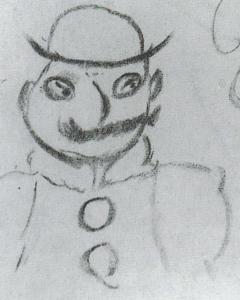
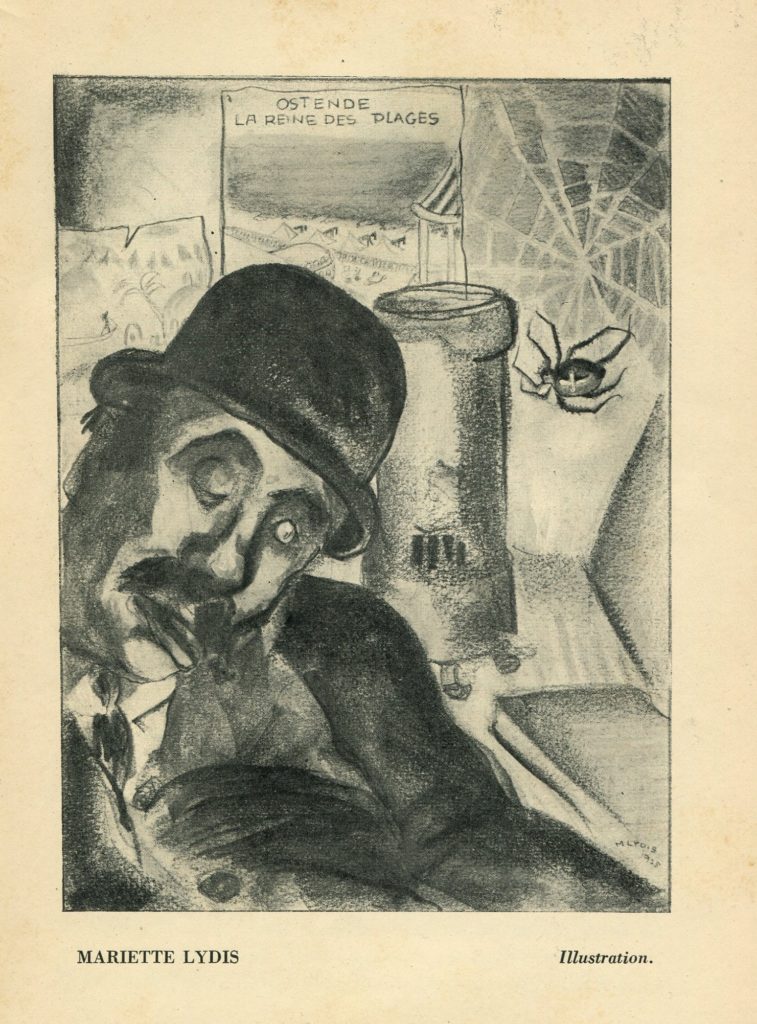
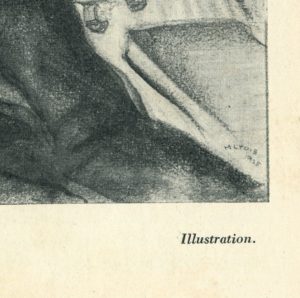
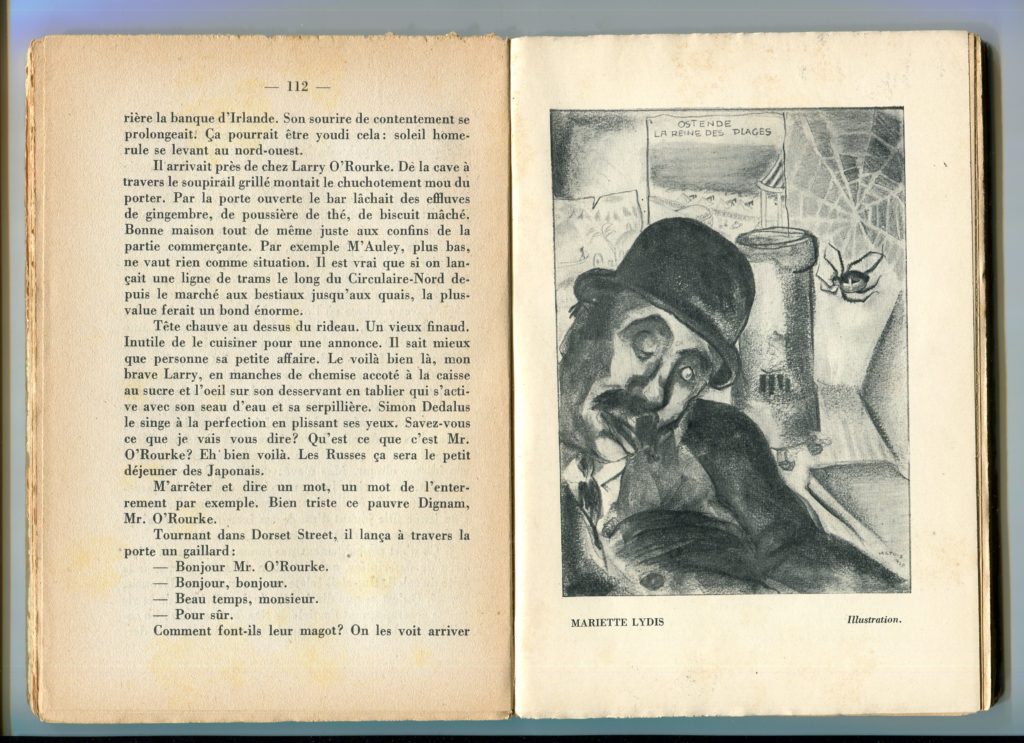
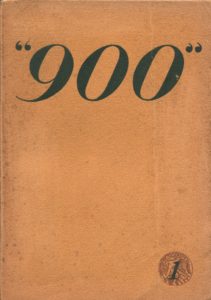
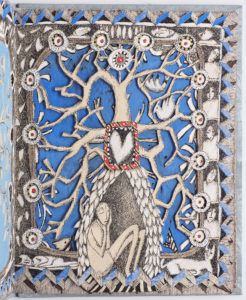
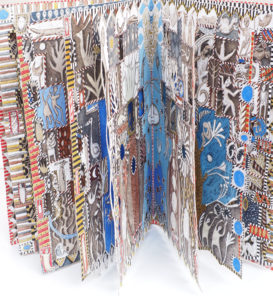
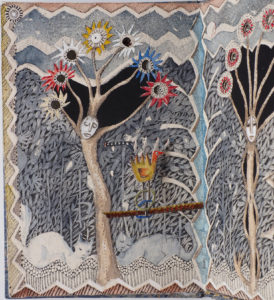
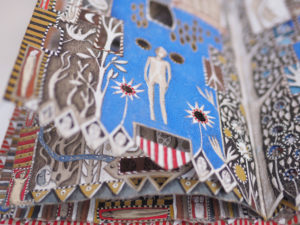

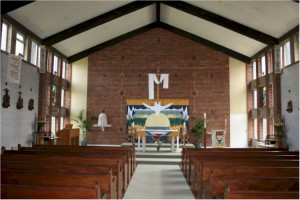 The ‘confessional’ in 1950s-built St Hugh’s was nothing like the comedy baroque chambers you see in the films—it was more like a well-maintained public convenience. If you were lucky, it would be Father Rourke behind the curtain, who was rather deaf and whose gentle Irish accent was so impenetrable that you couldn’t be upset by his response. He would listen to your confession and then invite you to consider ‘crushing the head of the serpent’, sending you away to recite three Hail Marys or an Act of Contrition.
The ‘confessional’ in 1950s-built St Hugh’s was nothing like the comedy baroque chambers you see in the films—it was more like a well-maintained public convenience. If you were lucky, it would be Father Rourke behind the curtain, who was rather deaf and whose gentle Irish accent was so impenetrable that you couldn’t be upset by his response. He would listen to your confession and then invite you to consider ‘crushing the head of the serpent’, sending you away to recite three Hail Marys or an Act of Contrition.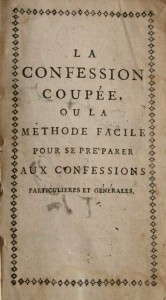 However, I realise we were not the first to come up with this solution. In fact, in the seventeenth-century cleric Christophe Leuterbreuver, had published a remarkable little pocket book along this line which became a bestseller, running to numerous editions. It was more than just a list though—being a fully-fledged livre à système incorporating hundreds of folding slips. I have now owned several copies of this book, the earliest being printed in 1695 the latest in 1751.
However, I realise we were not the first to come up with this solution. In fact, in the seventeenth-century cleric Christophe Leuterbreuver, had published a remarkable little pocket book along this line which became a bestseller, running to numerous editions. It was more than just a list though—being a fully-fledged livre à système incorporating hundreds of folding slips. I have now owned several copies of this book, the earliest being printed in 1695 the latest in 1751.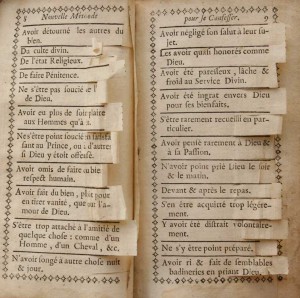 The sinner can mark the entries relevant to him or her by lifting the corresponding printed slips and then replacing them later so that no-one need ever know what was confessed. In reality, the lifted slips were often folded to mark them more clearly and it is, of course, intriguing to see which of the hundreds of sins have been marked.
The sinner can mark the entries relevant to him or her by lifting the corresponding printed slips and then replacing them later so that no-one need ever know what was confessed. In reality, the lifted slips were often folded to mark them more clearly and it is, of course, intriguing to see which of the hundreds of sins have been marked. 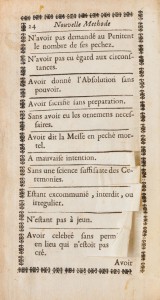 The book as a whole provides an uncommonly intimate view of the soul, akin to listing at the door of the confessional. The sins are set out according to the Ten Commandments and provide a glittering array of human failings. This is not a book for children and one wonders whether its popularity was as much because it provided such a panorama of the dark side of the soul. The list of sins for the ninth commandment, for example includes memoranda for ‘Avoir eu des pensées & des désirs lascifs. Y avoir eu de la délectation… Avoir prêté consentement aux illusions nocturnes… Avoit employé l’art magique des breuvages, & choses semblables, pour engager quelque personne en amour… Avoir dit des chansons lascives. Avoir dit les contes, & tenu des entretiens lascifs. Avoir fait des billets & écrits lascifs. Avoir eu, lû, & donné les Livres lascifs… Avoir jetté des regards déshonnêtes…’
The book as a whole provides an uncommonly intimate view of the soul, akin to listing at the door of the confessional. The sins are set out according to the Ten Commandments and provide a glittering array of human failings. This is not a book for children and one wonders whether its popularity was as much because it provided such a panorama of the dark side of the soul. The list of sins for the ninth commandment, for example includes memoranda for ‘Avoir eu des pensées & des désirs lascifs. Y avoir eu de la délectation… Avoir prêté consentement aux illusions nocturnes… Avoit employé l’art magique des breuvages, & choses semblables, pour engager quelque personne en amour… Avoir dit des chansons lascives. Avoir dit les contes, & tenu des entretiens lascifs. Avoir fait des billets & écrits lascifs. Avoir eu, lû, & donné les Livres lascifs… Avoir jetté des regards déshonnêtes…’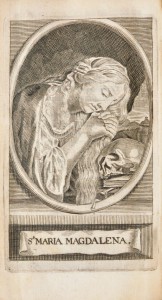
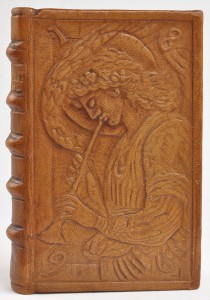 This time last year, I had just returned from a visit to Scandinavia. In my bag was this tiny book, found on the shelves of a Copenhagen bookshop, where it was hidden in the triple-shelved books of the theology section, wedged beside the water pipes. I had recognised the binding as being in the style of the Guild of Women Binders, with its modelled goatskin covers. Though an old pencilled note in the front suggested that the cover depicted Pan with his flute, the image looked more like a Burne-Jones angel to me. The book itself is an unremarkable edition of the Imitatio Christi by Thomas a Kempis. The binding is dated 1896.
This time last year, I had just returned from a visit to Scandinavia. In my bag was this tiny book, found on the shelves of a Copenhagen bookshop, where it was hidden in the triple-shelved books of the theology section, wedged beside the water pipes. I had recognised the binding as being in the style of the Guild of Women Binders, with its modelled goatskin covers. Though an old pencilled note in the front suggested that the cover depicted Pan with his flute, the image looked more like a Burne-Jones angel to me. The book itself is an unremarkable edition of the Imitatio Christi by Thomas a Kempis. The binding is dated 1896.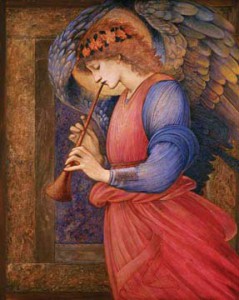 National Museums Liverpool
National Museums Liverpool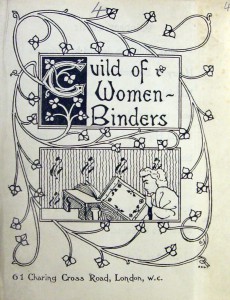
 The binding has been positively identified as the work of one ‘Miss Maclagan’, probably a pupil of Annie McDonald, who has carefully copied a detail of Burne-Jones’s original, probably from a photographic reproduction. Graham Hogg has also discovered that this very book was exhibited at the 1898 London exhibition of the Guild, where it was item 93 and exhibited as an example of the work of the Edinburgh School.
The binding has been positively identified as the work of one ‘Miss Maclagan’, probably a pupil of Annie McDonald, who has carefully copied a detail of Burne-Jones’s original, probably from a photographic reproduction. Graham Hogg has also discovered that this very book was exhibited at the 1898 London exhibition of the Guild, where it was item 93 and exhibited as an example of the work of the Edinburgh School.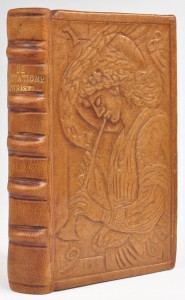
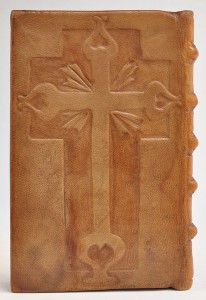
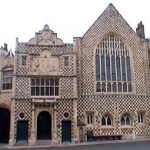 A few days ago I visited the ancient town of King’s Lynn. It was a memorable trip, not least for being booked-ended by glimpses of the great medieval cathedrals of Peterborough (underrated, I think) and Ely (the much-loved ‘Ship of the Fens’). Lynn, once one of the busiest sea-ports in Europe, had an eerie autumnal quietness; low clouds hung over the fenland approaches and the tide was disquietingly high in the Ouse estuary.
A few days ago I visited the ancient town of King’s Lynn. It was a memorable trip, not least for being booked-ended by glimpses of the great medieval cathedrals of Peterborough (underrated, I think) and Ely (the much-loved ‘Ship of the Fens’). Lynn, once one of the busiest sea-ports in Europe, had an eerie autumnal quietness; low clouds hung over the fenland approaches and the tide was disquietingly high in the Ouse estuary. The King’s Lynn Red Register is then, the earliest surviving English paper book. I realise that, had I been paying attention, I would have noticed it even has its own blue plaque outside the town-hall, though it doesn’t tell us why it’s important.
The King’s Lynn Red Register is then, the earliest surviving English paper book. I realise that, had I been paying attention, I would have noticed it even has its own blue plaque outside the town-hall, though it doesn’t tell us why it’s important.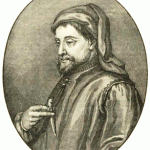 I’m fascinated by the people who made medieval administrative records. It seems to me that, just like the IT wizards of the 21st century, it is they who were experimenting with new technologies for recording day-to-day experience. The Red Register of Lynn is perhaps just one example of how far ahead of their time they could be. They were often people of extraordinary capability and imagination. It’s no coincidence that people such as Geoffrey Chaucer, controller of customs at London, was also a full-time administrative writer. It has been argued that the explosion of English lay-literacy in the fourteenth century came about in part through advances in literate technology among administrators in the great towns of England. That is another story and one I’m certainly encouraged to revisit after my archival explorations at Lynn…
I’m fascinated by the people who made medieval administrative records. It seems to me that, just like the IT wizards of the 21st century, it is they who were experimenting with new technologies for recording day-to-day experience. The Red Register of Lynn is perhaps just one example of how far ahead of their time they could be. They were often people of extraordinary capability and imagination. It’s no coincidence that people such as Geoffrey Chaucer, controller of customs at London, was also a full-time administrative writer. It has been argued that the explosion of English lay-literacy in the fourteenth century came about in part through advances in literate technology among administrators in the great towns of England. That is another story and one I’m certainly encouraged to revisit after my archival explorations at Lynn…